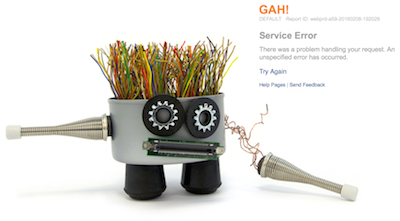Recent Posts
AOL broken (again)
- laura
- Feb 8, 2016
 I am, apparently, still one of the top hits when you Google for AOL. When things break at AOL, this means I get lots of contacts, comments and even phone calls from people looking for help.
I am, apparently, still one of the top hits when you Google for AOL. When things break at AOL, this means I get lots of contacts, comments and even phone calls from people looking for help.
I’m really not AOL support. (Really. I’m not. If you’re an AOL user I can’t help you log into your account. Please don’t call. Please don’t ask. Contact AOL directly.)
BUT! So many AOL users thinking I am means I learn about AOL problems fairly early in the cycle. As of this morning I’m getting a lot of reports that AOL is broken. I tried logging into my account and got the following:
On the delivery end mail is still being accepted. I can send mail to that particular account, even though I can’t log into it. But, senders may see lower engagement from AOL users until the issue is resolved.
Things you need to read: 2/5/16
- laura
- Feb 6, 2016
 Ask the Expert: How Can Email Marketers Stay Out of Gmail Jail and in the Inbox? The expert in question is an old friend of mine, Andrew Barrett. I met Andrew online in the late 90s, and we worked together (briefly) at MAPS. He was out of email for a while, but I’m pleased he came back to share his talents with us. The information in the article is valuable for anyone who struggles with getting to the Gmail inbox.
Ask the Expert: How Can Email Marketers Stay Out of Gmail Jail and in the Inbox? The expert in question is an old friend of mine, Andrew Barrett. I met Andrew online in the late 90s, and we worked together (briefly) at MAPS. He was out of email for a while, but I’m pleased he came back to share his talents with us. The information in the article is valuable for anyone who struggles with getting to the Gmail inbox.
Unclutter Your Inbox, Archive & Keep Your Messages. Shiv Shankar talks about some new features at Yahoo Mail. With a simple click, you can archive email so it’s available to search, but not cluttering up your inbox. One of the things that jumped out at me from that article is that Yahoo is providing 1 TB of storage. That’s more than Google!
The EEC is doing a survey on the impact of CASL and want to hear from marketers. Go check out their blog post and take their survey.
Sparkpost has a guest blog from Alex Garcia-Tobar, co-founder of Valimail about common DKIM failures. I’ve met Alex a few times and I’ve always found him a pleasure to talk to. Alex is somewhat new in the email space, but he really gets some of the challenges in the authentication space. A lot of the issues he mentions in that blog post like lack of key rotation and shared keys are some of the technical debt I was talking about in my predictions for 2016 post.
What links have you read this week that are worth sharing?
January 2016: The Month in Email
- laura
- Feb 4, 2016
 Happy 2016! We started off the year with a few different “predictions” posts. As always, I don’t expect to be right about everything, but it’s a useful exercise for us to look forward and think about where things are headed.
Happy 2016! We started off the year with a few different “predictions” posts. As always, I don’t expect to be right about everything, but it’s a useful exercise for us to look forward and think about where things are headed.
I joined nine other email experts for a Sparkpost webinar on 2016 predictions, which was a lot of fun (see my wrap up post here), and then I wrote a long post about security and authentication, which I think will be THE major topic in email this year both in policy and in practice (see my post about an exploit involving Trend Micro and another about hijacked Verizon addresses). Expect to hear more about this 2016 continues.
My other exciting January project was the launch of my “Ask Laura” column, which I hope will prove a great resource for people with questions about email. Please let me know if you have any questions you’d like to see me answer for your company or your clients — I’ll obscure any identifying information and generalize the answers to be most widely applicable for our readers.
In other industry news, it’s worth noting that Germany has ruled it illegal to harvest users’ address books (as Facebook and other services do). Why does that make sense? Because we’re seeing more and more phishing and scams that rely on social engineering.
In best practices, I wrote about triggered and transactional emails, how they differ, and what to consider when implementing them as part of your email program. Steve describes an easy-to-implement best practice that marketers often ignore: craft your mails so the most important information is shown as text.
I re-published an older post about SMTP rules that has a configuration checklist you might find useful as you troubleshoot any issues. And a newer issue you might be seeing is port25 blocking, which is important if you are hosting your own email senders or using SMTP to send to your ESP.
Finally, I put together some thoughts about reporting abuse. We work closely with high-volume abuse desks who use our Abacus software, and we know that it’s often not worth the time for an individual to report an incident – but I still think it’s worthwhile to have the infrastructure in place, and I wrote about why that is.
Enter clickbait here
- laura
- Feb 4, 2016
Yesterday I talked about how the truth matters in email marketing. But that’s not the only place the truth matters.
Today I found myself in a bit of a … discussion on Facebook. It ended up being a lesson in why you should never trust the clickbait headline. I also realized there are parallels with email best practices and how we share them with people.
The truth matters.
- laura
- Feb 3, 2016
 Call within the next 10 minutes…
Call within the next 10 minutes…
Consumers with last names starting with O – Z can call tomorrow…
Only 5 seats left at this price!
All of these are common marketing techniques designed to prompt consumers to buy. It’s not a new idea, create a sense of urgency and people are more likely to buy.
I think some marketers are so used to making outrageous claims to support their marketing goals, that it doesn’t occur to them that the truth matters to some people.
There’s almost no better way to get me to send in a spam complaint than to send me an email with a claim about how I opted in.
Example:
Purchased lists and ESPs: 9 months later
- laura
- Feb 2, 2016
It was about 8 months ago I published a list of ESPs that prohibit the use of purchased lists. There have been a number of interesting responses to that post.
ESPs wanted to be added to the list
The first iteration of the list was crowdsourced from different ESP representatives. They shared the info they had with each other. With their permission, I put it together into a post and published it here. Since then, I’ve had a trickle of ESPs asking to be added to the list. I’m happy to add any ESP. The only requirement is a privacy policy (or AUP) that states no purchased lists.
People reference the list regularly
I’ve had a lot of ESP deliverability folks send thanks for writing this post. They tell me they reference it regularly when dealing with clients. It’s also been listed as “one of the best blog posts of 2015” by Pardot.
Some 2016 predictions build on the post
I’ve read multiple future predictions that talk about how the era of purchased lists is over. I don’t think they’re wrong. I think that purchased lists are going to be deliverability nightmares on an internet where users wanting a mail is a prime factor in inbox deliverability. They’re already difficult to deliver, but it’s going to get worse.
Not everyone thinks this is a good post. In fact, I just recently got an comment about how wrong I was, and… well, I’ll just share it because I don’t think my summary of it will do it any justice.
Ask Laura
- laura
- Jan 29, 2016
An Advice Column on Email Delivery
When we work with brands and senders to improve email delivery, there are many questions that come up again and again. For 2016, we thought it might be interesting to answer some of those questions here on the blog so others can benefit from the information.
Confused about delivery in general? Trying to keep up on changing policies and terminology? Need some Email 101 basics? This is the place to ask. We can’t answer specific questions about your server configuration or look at your message structure for the column (please get in touch if you’d like our help with more technical or forensic investigations!), but we’d love to answer your questions about how email works, trends in the industry, or the joys and challenges of cohabiting with felines.
Your pal,
Laura
Dear Laura,
I’m having a hard time explaining to our marketing team why we shouldn’t send email to addresses on our lists with very low read rates, that are dormant but not bouncing, or that spend less than 2 seconds reading our mail. I’m also struggling to convince them that it’s not a good idea to dramatically increase email volume during the holidays (i.e. going from one send/day to 2-3 sends/day).
We already segment based on recency, engagement, and purchase behavior, and we also have some triggered messaging based on user behavior.
Can you help me find a way to help explain why sometimes less is more?
Thanks,
The Floodgates Are Open
Dear Floodgates,
ISPs ask two fundamental questions about email when it comes in:
- Is it safe?
- Is it wanted?
If the answer to both those questions is yes, the mail is delivered to the inbox.
Read MoreMore 2016 predictions
- laura
- Jan 28, 2016
Gerald Marshall of Email Industries looked at over a hundred different 2016 predictions and organized them for us. Most predictions went into the segmentation and personalization and automation buckets. Only a few predictions were security related, which either means I’m ahead of the curve or on a different planet. Time will tell.
Following the SMTP rules
- laura
- Jan 28, 2016
An old blog post from 2013, that’s still relevant today.
“Blocked for Bot-like Behavior”
An ESP asked about this error message from Hotmail and what to do about it.
“Bot-like” behaviour usually means the sending server is doing something that bots also do. It’s not always that they’re spamming, often it’s a technical issue. But the technical problems make the sending server look like a bot, so the ISP is not taking any chances and they’re going to stop accepting mail from that server.
If you’re an ESP what should you look for when tracking down what the problem is?
First make sure your server isn’t infected with anything and that you’re not running an open relay or proxy. Second, make sure your customers aren’t compromised or have had their accounts hijacked.
Then start looking at your configuration.
HELO/EHLO values
More predictions for 2016
- laura
- Jan 27, 2016
This morning I had the pleasure of participating in the SparkPost 10 experts in 50 minutes webinar. I am honored to be included with such a smart group of forward thinking leaders in the email space. The webinar was also live tweeted using #emailpros. I’ve put together some of my favorite tweets from today.
The webinar was also live tweeted using #emailpros. I’ve put together some of my favorite tweets from today.
What was fun for me was listening to the similarities and differences in our views. Multiple people mentioned authentication and security. Other people focused on display and creatives. Privacy and big data was another theme through multiple speakers. Our Canadian representative gave us a good summary of CASL enforcement. We also had some insightful comments about how deliverability is changing for the B2B market.
I’m definitely stealing B2H. I tweeted B2Host, but also saw someone use B2Human. Both work. It’s a term that really captures what deliverability is about. The human behind the email address is critical for getting to the inbox. B2H! Beautiful.
Categories
Tags
- 2010
- 2016
- 2fa
- 419
- 4xx
- 554
- 5xx
- @
- Aarp
- Abacus
- Abandoned
- Aboutmyemail
- Abuse
- Abuse Desk
- Abuse Enforcement
- Abuse Prevention
- Academia
- Accreditation
- Acme
- Acquisition
- Address Book
- Addresses
- Administrivia
- Adsp
- Advanced Delivery
- Advertiser
- Advertising
- Advice
- Affiliate
- Affiliates
- After the Email
- Alerts
- Algorithm
- Alice
- Alignment
- Allcaps
- Alt Text
- AMA
- Amazon
- Amp
- Amsterdam
- Analysis
- Anecdotes
- Anti-Spam
- Anti-Spam Laws
- Anti-Spammers
- Antwort
- AOL
- Appeals
- Appearances
- Appending
- Apple
- Arc
- Arf
- Arrest
- Arrests
- Ascii
- Asides
- Ask Laura
- Askwttw
- Assertion
- Assumptions
- ATT
- Attacks
- Attention
- Attrition
- Audit
- Authentication
- Authentication. BT
- Autonomous
- Award
- B2B
- B2C
- Backhoe
- Backscatter
- Backus-Naur Form
- Banks
- Barracuda
- Barry
- Base64
- Base85
- Bcp
- Bear
- Bears
- Behaviour
- Benchmark
- BESS
- Best Practices
- Bgp
- Bimi
- Bit Rot
- Bitly
- Bizanga
- Black Friday
- Blackfriday
- Blacklist
- Blacklists
- Blast
- Blo
- Block
- Blockin
- Blocking
- Blocklist
- Blocklisting
- Blocklists
- Blocks
- Blog
- Blog Links
- Blogroll
- Blogs
- Bob
- Boca
- Bofa
- Book Review
- Bot
- Botnet
- Botnets
- Bots
- Bounce
- Bounce Handling
- Bounces
- Branding
- Brands
- Breach
- Breaches
- Breech
- Bronto
- Browser
- Bsi
- Bucket
- Bulk
- Bulk Folder
- Bulk Mail
- Business
- Business Filters
- Buying Leads
- Buying Lists
- C-28
- CA
- Caa
- Cabbage
- Cache
- Cadence
- CAH
- California
- Campaign
- CAN SPAM
- Canada
- Candy
- Candycandycandy
- Canonicalization
- Canspam
- Captcha
- Career Developmnent
- Careers at WttW
- Cargo Cult
- Case Law
- Cases
- CASL
- Cat
- Cbl
- CDA
- Cert
- Certification
- CFL
- Change
- Charter
- Cheat
- Cheese
- Choicepoint
- Choochoo
- Christmas
- Chrome
- Cidr
- Cisco
- Civil
- Clear.net
- Clearwire.net
- Cli
- Click
- Click Through
- Click Tracking
- Clicks
- Clickthrough
- Client
- Cloudflare
- Cloudmark
- Cname
- Co-Reg
- Co-Registration
- Cocktail
- Code
- COI
- Comcast
- Comments
- Commercial
- Communication
- Community
- Comodo
- Comparison
- Competitor
- Complaint
- Complaint Rates
- Complaints
- Compliancce
- Compliance
- Compromise
- Conference
- Conferences
- Confirmation
- Confirmed (Double) Opt-In
- Confirmed Opt-In
- Congress
- Consent
- Conservatives
- Consistency
- Constant Contact
- Consultants
- Consulting
- Content
- Content Filters
- Contracts
- Cookie
- Cookie Monster
- COPL
- Corporate
- Cost
- Court Ruling
- Cox
- Cox.net
- Cpanel
- Crib
- Crime
- CRM
- Crowdsource
- Crtc
- Cryptography
- CS&M
- CSRIC
- CSS
- Curl
- Customer
- Cyber Monday
- Czar
- Data
- Data Hygiene
- Data Security
- Data Segmentation
- Data Verification
- DBL
- Dbp
- Ddos
- Dea
- Dead Addresses
- Dedicated
- Dedicated IPs
- Defamation
- Deferral
- Definitions
- Delays
- Delisting
- Deliverability
- Deliverability Experts
- Deliverability Improvement
- Deliverability Summit
- Deliverability Week
- Deliverability Week 2024
- Deliverabiltiy
- DeliverabiltyWeek
- Delivery Blog Carnival
- Delivery Discussion
- Delivery Emergency
- Delivery Experts
- Delivery Improvement
- Delivery Lore
- Delivery News
- Delivery Problems
- Dell
- Design
- Desks
- Dhs
- Diagnosis
- Diff
- Dig
- Direct Mag
- Direct Mail
- Directives
- Discounts
- Discovery
- Discussion Question
- Disposable
- Dk
- DKIM
- Dkimcore
- DMA
- Dmarc
- DNS
- Dnsbl
- Dnssec
- Docs
- Doingitright
- Domain
- Domain Keys
- Domain Reputation
- DomainKeys
- Domains
- Domains by Proxy
- Dontpanic
- Dot Stuffing
- Dotcom
- Double Opt-In
- Dublin
- Dyn
- Dynamic Email
- E360
- Earthlink
- Ec2
- Ecoa
- Economics
- ECPA
- Edatasource
- Edns0
- Eec
- Efail
- Efax
- Eff
- Election
- Email Address
- Email Addresses
- Email Change of Address
- Email Client
- Email Design
- Email Formats
- Email Marketing
- Email Verification
- Emailappenders
- Emailgeeks
- Emails
- Emailstuff
- Emoji
- Emoticon
- Encert
- Encryption
- End User
- Endusers
- Enforcement
- Engagement
- Enhanced Status Code
- Ennui
- Entrust
- Eol
- EOP
- Epsilon
- Esp
- ESPC
- ESPs
- EU
- Ev Ssl
- Evaluating
- Events
- EWL
- Exchange
- Excite
- Expectations
- Experience
- Expires
- Expiring
- False Positives
- FAQ
- Fathers Day
- Fbl
- FBL Microsoft
- FBLs
- Fbox
- FCC
- Fcrdns
- Featured
- Fedex
- Feds
- Feedback
- Feedback Loop
- Feedback Loops
- Fiction
- Filter
- Filter Evasion
- Filtering
- Filterings
- Filters
- Fingerprinting
- Firefox3
- First Amendment
- FISA
- Flag Day
- Forensics
- Format
- Formatting
- Forms
- Forwarding
- Fraud
- Freddy
- Frequency
- Friday
- Friday Spam
- Friendly From
- From
- From Address
- FTC
- Fussp
- Gabbard
- GDPR
- Geoip
- Gevalia
- Gfi
- Git
- Giveaway
- Giving Up
- Global Delivery
- Glossary
- Glyph
- Gmail
- Gmails
- Go
- Godaddy
- Godzilla
- Good Email Practices
- Good Emails in the Wild
- Goodmail
- Google Buzz
- Google Postmaster Tools
- Graphic
- GreenArrow
- Greylisting
- Greymail
- Groupon
- GT&U
- Guarantee
- Guest Post
- Guide
- Habeas
- Hack
- Hacking
- Hacks
- Hall of Shame
- Harassment
- Hard Bounce
- Harvesting
- Harvey
- Hash
- Hashbusters
- Headers
- Heartbleed
- Hearts
- HELO
- Help
- Henet
- Highspeedinternet
- Hijack
- History
- Holiday
- Holidays
- Holomaxx
- Hostdns4u
- Hostile
- Hostname
- Hotmail
- How To
- Howto
- Hrc
- Hsts
- HTML
- HTML Email
- Http
- Huey
- Humanity
- Humor
- Humour
- Hygiene
- Hypertouch
- I18n
- ICANN
- Icloud
- IContact
- Identity
- Idiots
- Idn
- Ietf
- Image Blocking
- Images
- Imap
- Inbox
- Inbox Delivery
- Inboxing
- Index
- India
- Indiegogo
- Industry
- Infection
- Infographic
- Information
- Inky
- Inline
- Innovation
- Insight2015
- Integration
- Internationalization
- Internet
- Intuit
- IP
- IP Address
- Ip Addresses
- IP Repuation
- IP Reputation
- IPhone
- IPO
- Ipv4
- Ipv6
- Ironport
- Ironport Cisco
- ISIPP
- ISP
- ISPs
- J.D. Falk Award
- Jail
- Jaynes
- JD
- Jobs
- Json
- Junk
- Juno/Netzero/UOL
- Key Rotation
- Keybase
- Keynote
- Kickstarter
- Kraft
- Laposte
- Lavabit
- Law
- Laws
- Lawsuit
- Lawsuits
- Lawyer
- Layout
- Lead Gen
- Leak
- Leaking
- Leaks
- Legal
- Legality
- Legitimate Email Marketer
- Letsencrypt
- Letstalk
- Linked In
- Links
- List Hygiene
- List Management
- List Purchases
- List the World
- List Usage
- List-Unsubscribe
- Listing
- Listmus
- Lists
- Litmus
- Live
- Livingsocial
- London
- Lookup
- Lorem Ipsum
- Lycos
- Lyris
- M3AAWG
- Maawg
- MAAWG2007
- Maawg2008
- MAAWG2012
- MAAWGSF
- Machine Learning
- Magill
- Magilla
- Mail Chimp
- Mail Client
- MAIL FROM
- Mail Privacy Protection
- Mail Problems
- Mail.app
- Mail.ru
- Mailboxes
- Mailchimp
- Mailgun
- Mailing Lists
- Mailman
- Mailop
- Mainsleaze
- Maitai
- Malicious
- Malicious Mail
- Malware
- Mandrill
- Maps
- Marketer
- Marketers
- Marketing
- Marketo
- Markters
- Maths
- Mcafee
- Mccain
- Me@privacy.net
- Measurements
- Media
- Meh
- Meltdown
- Meme
- Mentor
- Merry
- Message-ID
- Messagelabs
- MessageSystems
- Meta
- Metric
- Metrics
- Micdrop
- Microsoft
- Milter
- Mime
- Minimal
- Minshare
- Minute
- Mit
- Mitm
- Mobile
- Models
- Monitoring
- Monkey
- Monthly Review
- Mpp
- MSN/Hotmail
- MSN/Hotmail
- MTA
- Mua
- Mutt
- Mx
- Myths
- Myvzw
- Needs Work
- Netcat
- Netsol
- Netsuite
- Network
- Networking
- New Year
- News
- News Articles
- Nhi
- NJABL
- Now Hiring
- NTP
- Nxdomain
- Oath
- Obituary
- Office 365
- Office365
- One-Click
- Only Influencers
- Oops
- Opaque Cookie
- Open
- Open Detection
- Open Rate
- Open Rates
- Open Relay
- Open Tracking
- Opendkim
- Opens
- Openssl
- Opt-In
- Opt-Out
- Optonline
- Oracle
- Outage
- Outages
- Outblaze
- Outlook
- Outlook.com
- Outrage
- Outreach
- Outsource
- Ownership
- Owning the Channel
- P=reject
- Pacer
- Pander
- Panel
- Password
- Patent
- Paypal
- PBL
- Penkava
- Permission
- Personalities
- Personalization
- Personalized
- Pgp
- Phi
- Philosophy
- Phish
- Phishers
- Phishing
- Phising
- Photos
- Pii
- PIPA
- PivotalVeracity
- Pix
- Pluscachange
- Podcast
- Policies
- Policy
- Political Mail
- Political Spam
- Politics
- Porn
- Port25 Blocking
- Postfix
- Postmaster
- Power MTA
- Practices
- Predictions
- Preferences
- Prefetch
- Preview
- Primers
- Privacy
- Privacy Policy
- Privacy Protection
- Private Relay
- Productive Mail
- Promotions
- Promotions Tab
- Proofpoint
- Prospect
- Prospecting
- Protocols
- Proxy
- Psa
- PTR
- Public Suffix List
- Purchased
- Purchased Lists
- Purchases
- Purchasing Lists
- Questions
- Quoted Printable
- Rakuten
- Ralsky
- Rant
- Rate Limiting
- Ray Tomlinson
- Rc4
- RDNS
- Read
- Ready to Post
- Readytopost
- Real People
- Realtime Address Verification
- Recaptcha
- Received
- Receivers
- Recipient
- Recipients
- Redirect
- Redsnapper
- Reference
- Registrar
- Registration
- Rejection
- Rejections
- Rejective
- Relationship
- Relevance
- Relevancy
- Removals
- Render Rate
- Rendering
- Repost
- Repudiation
- Reputation
- Requirements
- Research
- Resources
- Responsive
- Responsive Design
- Responsys
- Retail
- Retired Domains
- Retro
- Return Path
- Return Path Certified
- ReturnPath
- Reunion.com
- Reverse Dns
- RFC
- RFC2047
- RFC2821/2822
- RFC5321/5322
- RFC5322
- RFC8058
- RFC821/822
- RFCs
- Roadr
- RoadRunner
- Rodney Joffe
- ROKSO
- Role Accounts
- Rollout
- RPost
- RPZ
- Rule 34
- Rules
- Rum
- Rustock
- S.1618
- SaaS
- Sales
- Salesforce
- Sass
- SBCGlobal
- Sbl
- Scam
- Scammers
- Scams
- Scanning
- Scraping
- Screamer
- Screening
- Script
- Sec
- Secure
- Security
- Segmentation
- Selligent
- Send
- Sender
- Sender Score
- Sender Score Certified
- Senderbase
- Senderid
- Senders
- Senderscore
- Sendgrid
- Sending
- Sendy
- Seo
- Service
- Services
- Ses
- Seth Godin
- SFDC
- SFMAAWG2009
- SFMAAWG2010
- SFMAAWG2014
- Shared
- Shell
- Shouting
- Shovel
- Signing
- Signups
- Silly
- Single Opt-In
- Slack
- Slicing
- Smarthost
- Smiley
- Smime
- SMS
- SMTP
- Snds
- Snowshoe
- Soa
- Socia
- Social Media
- Social Networking
- Soft Bounce
- Software
- Sony
- SOPA
- Sorbs
- Spam
- Spam Blocking
- Spam Definition
- Spam Filtering
- Spam Filters
- Spam Folder
- Spam Law
- Spam Laws
- Spam Reports
- Spam Traps
- Spam. IMessage
- Spamarrest
- Spamassassin
- Spamblocking
- Spamcannibal
- Spamcon
- Spamcop
- Spamfiltering
- Spamfilters
- Spamfolder
- Spamhaus
- Spamhause
- Spammer
- Spammers
- Spammest
- Spamming
- Spamneverstops
- Spamresource
- Spamtrap
- Spamtraps
- Spamza
- Sparkpost
- Speaking
- Special Offers
- Spectre
- SPF
- Spoofing
- SproutDNS
- Ssl
- Standards
- Stanford
- Starttls
- Startup
- State Spam Laws
- Statistics
- Storm
- Strategy
- Stunt
- Subject
- Subject Lines
- Subscribe
- Subscriber
- Subscribers
- Subscription
- Subscription Process
- Success Stories
- Suing
- Suppression
- Surbl
- Sureclick
- Suretymail
- Survey
- Swaks
- Syle
- Symantec
- Tabbed Inbox
- Tabs
- Tagged
- Tagging
- Target
- Targeting
- Techincal
- Technical
- Telnet
- Template
- Tempo
- Temporary
- Temporary Failures
- Terminology
- Testing
- Text
- Thanks
- This Is Spam
- Throttling
- Time
- Timely
- TINS
- TLD
- Tlp
- TLS
- TMIE
- Tmobile
- Too Much Mail
- Tool
- Tools
- Toomuchemail
- Tor
- Trademark
- Traffic Light Protocol
- Tragedy of the Commons
- Transactional
- Transition
- Transparency
- Traps
- Travel
- Trend/MAPS
- Trend Micro
- Trend/MAPS
- Trigger
- Triggered
- Troubleshooting
- Trustedsource
- TWSD
- Txt
- Types of Email
- Typo
- Uce
- UCEprotect
- Unblocking
- Uncategorized
- Unexpected Email
- Unicode
- Unroll.me
- Unsolicited
- Unsubcribe
- Unsubscribe
- Unsubscribed
- Unsubscribes
- Unsubscribing
- Unsubscription
- Unwanted
- URIBL
- Url
- Url Shorteners
- Usenet
- User Education
- Utf8
- Valentine's Day
- Validation
- Validity
- Value
- Valueclick
- Verification
- Verizon
- Verizon Media
- VERP
- Verticalresponse
- Vetting
- Via
- Video
- Violence
- Virginia
- Virtumundo
- Virus
- Viruses
- Vmc
- Vocabulary
- Vodafone
- Volume
- Vzbv
- Wanted Mail
- Warmup
- Weasel
- Webinar
- Webmail
- Weekend Effect
- Welcome Emails
- White Space
- Whitelisting
- Whois
- Wiki
- Wildcard
- Wireless
- Wiretapping
- Wisewednesday
- Women of Email
- Woof
- Woot
- Wow
- Wtf
- Wttw in the Wild
- Xbl
- Xfinity
- Xkcd
- Yahoo
- Yahoogle
- Yogurt
- Zoidberg
- Zombie
- Zombies
- Zoominfo
- Zurb